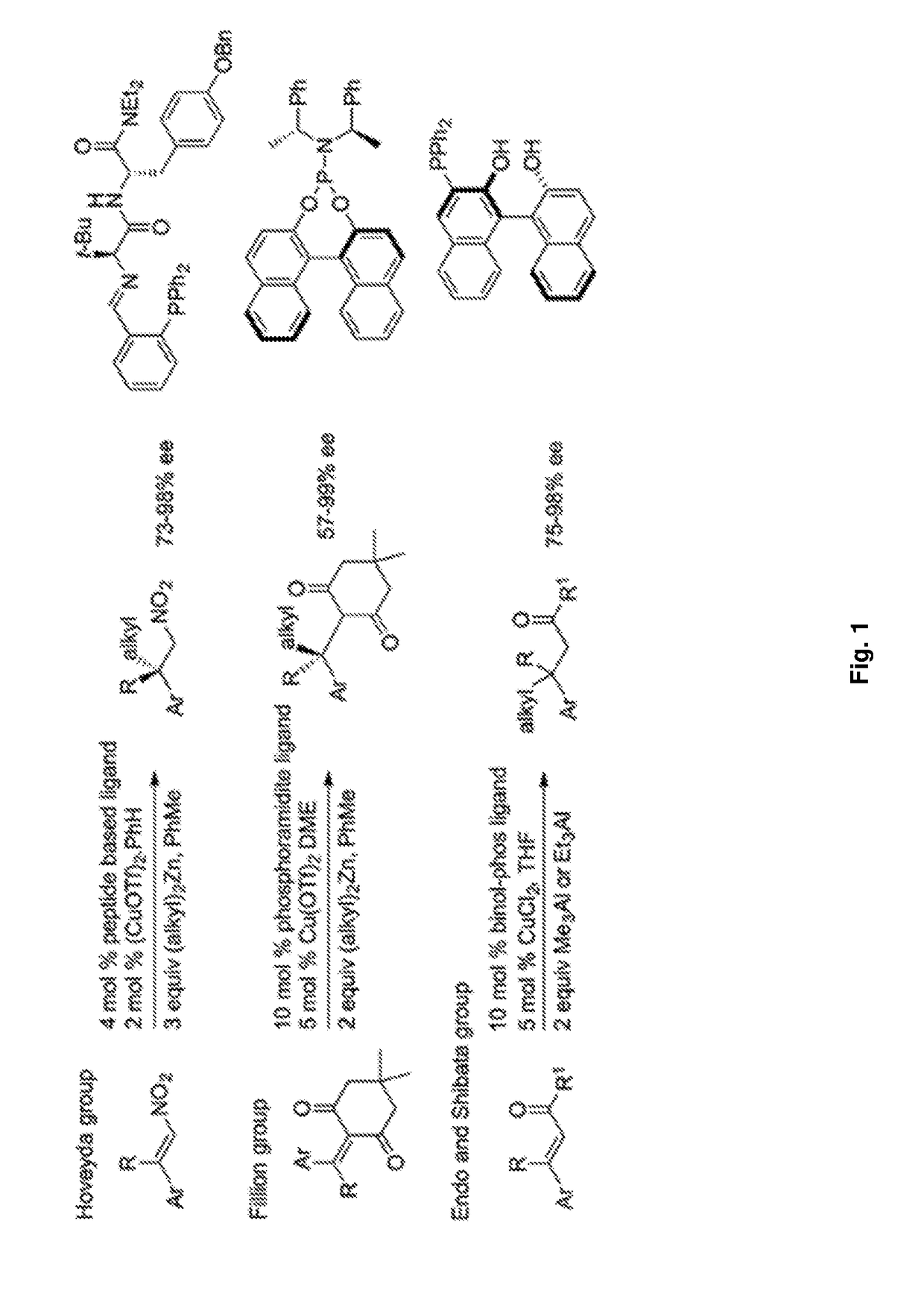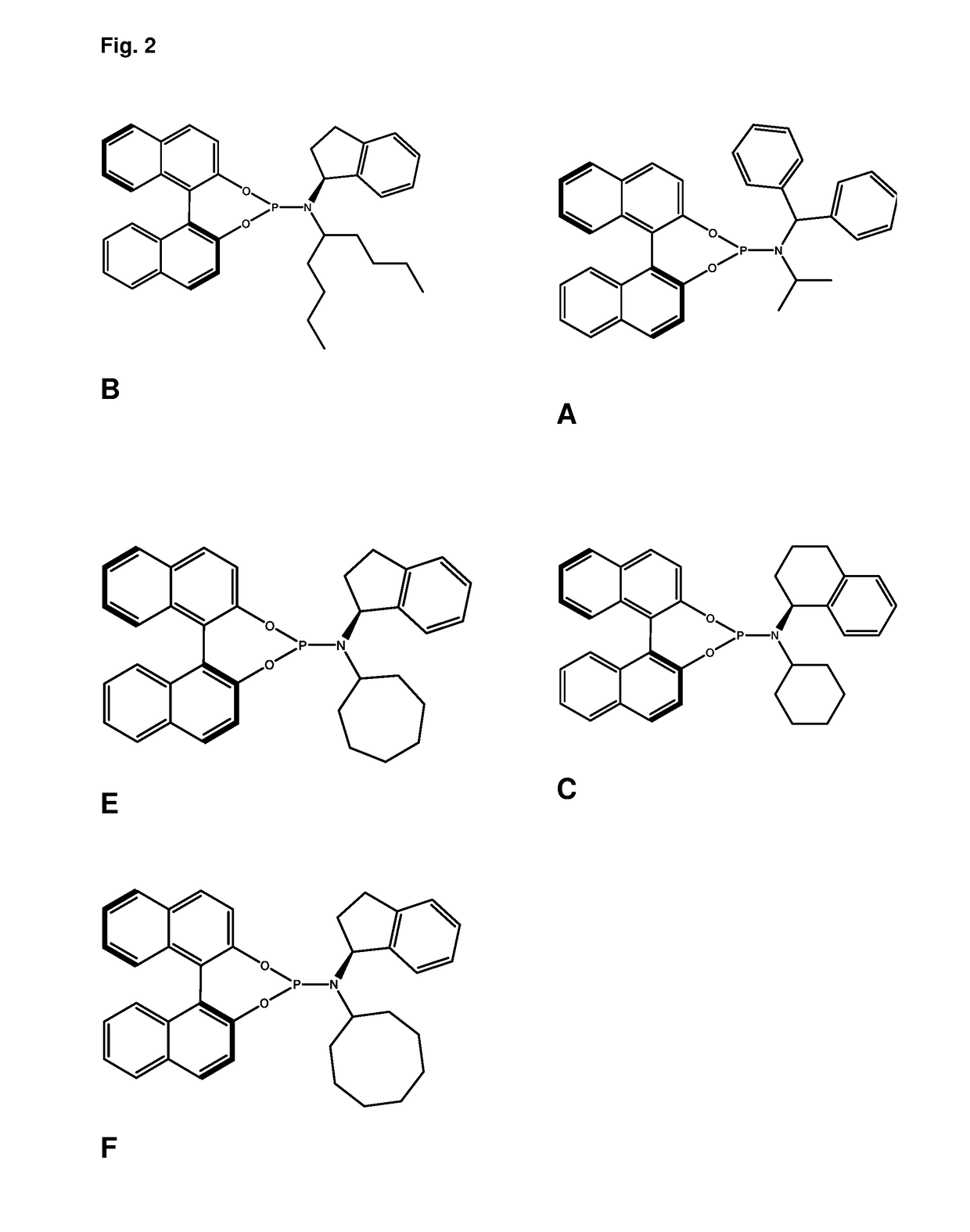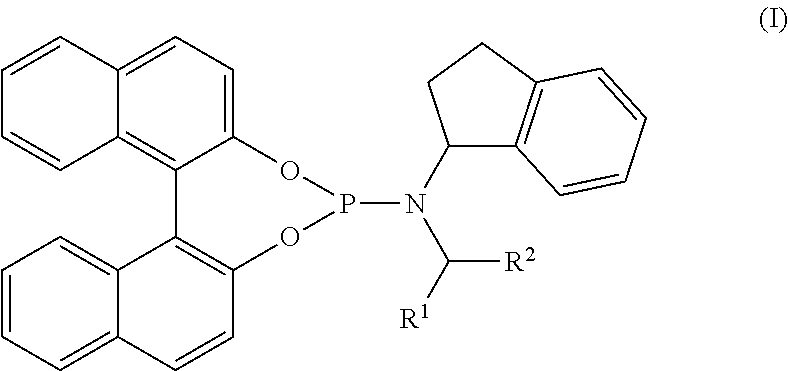Ligands and catalysts
a technology applied in the field of ligands and catalysts, can solve the problems of difficult synthesis of quaternary centres, particularly in acyclic systems, and lower levels of enantioselectivity, and achieve the difficult task of achieving high enantioselectivity
- Summary
- Abstract
- Description
- Claims
- Application Information
AI Technical Summary
Benefits of technology
Problems solved by technology
Method used
Image
Examples
example 1
of (+)-(11bS)—N—((S)-2,3-dihydro-1H-inden-1-yl)-N-(nonan-5-yl)dinaphtho[2,1-d:1′,2′-f][1,3,2]dioxaphosphepin-4-amine (Ligand B)
(+)-(S)—N-(nonan-5-yl)-2,3-dihydro-1H-inden-1-amine
[0129]
[0130]TiCl4 (3.9 mL (1 M solution in CH2Cl2), 1.1 eq, 3.9 mmol), was added slowly to an ice-cooled solution of 2-nonan-5-one (1.33 mL, 1.0 eq, 7.7 mmol) in CH2Cl2. The solution was stirred for 10 minutes at room temperature and then a 2 M solution of (S)-(+)-1-Aminoindane (0.45 mL, 2.2 eq, 3.5 mmol), in THF was added dropwise to the reaction mixture. The reaction mixture was stirred for 3 hours before a 1 M solution of NaB(CN)H3 (1.2 eq.) in THF, and then MeOH (10 mL) were added slowly to the reaction mixture and stirring at room temperature was continued for 48 hours. NaOH (2M aq. solution) was added slowly and the mixture was stirred for 30 min before filteration over celite and washing with EtOAc (30 mL). The mixture was partitioned between the aqueous and organic layers and the aqueous phase extrac...
example 2
of (+)-(11bS)—N-cycloheptyl-N—((S)-2,3-dihydro-1H-inden-1-yl)dinaphtho[2,1-d:1′,2′f][1,3,2]dioxaphosphepin-4-amine (Ligand E)
[0144]
[0145]Triethylamine (0.8 mL, 5.0 eq., 6.0 mmol), was added dropwise to a stirred, ice-cooled solution of PCl3 (0.11 mL, 1.0 eq., 1.2 mmol) in CH2Cl2. The ice bath was removed and the solution left to warm to room temperature before (S)—N-cyclohexyl-2, 3-dihydro-1H-inden-1-amine (0.28 g, 1.0 eq. 1.2 mmol) was added to the stirred solution in one portion. After 5 hours, (S)-binaphthol (0.33 g, 1.0 eq. 1.2 mmol) was tipped into the suspension and the reaction mixture was left to stir for another 15 hours. The mixture was then filtered over an 2 cm pad of celite and silica gel, and CH2Cl2 (30 mL) was used to rinse the pad. The filtrate was concentrated to give a yellow residue and after flash column chromatography (petroleum ether: CH2Cl2: Et3N, 80:20:1; SiO2) the ligand was obtained as a white crystalline solid (0.37 g, 57%).
[0146]1H NMR (500 MHz, Chlorofor...
example 3
of (+)-(11bS)—N-cyclooctyl-N—((S)-2,3-dihydro-1H-inden-1-yl)dinaphtho[2,1-d:1′,2′-f][1,3,2]dioxaphosphepin-4-amine (Ligand F)
(+)-(S)—N-cyclooctyl-2,3-dihydro-1H-inden-1-amine
[0152]
[0153]According to a modified procedure from Davies and co-workers,25 cyclooctanone (1.47 g, 1.5 eq. 11.6 mmol) was added to a stirring solution of (S)-(+)-1-Aminoindane (1.00 mL, 1.0 eq. 7.76 mmol.) in THF at room temperature. After 5 minutes, Na(OAc)3H (2.50 g, 1.5 eq., 11.6 mmol) was tipped into the mixture. The reaction was kept under room temperature for 48 hours, and the resulting suspension was added to a 1:1 mixture of Et2O and NaHCO3 (aq. sat.) and stirred for another half an hour. The mixture was partitioned between the aqueous and Et2O layers and the aqueous phase extracted with Et2O three times. The combined organic phase was concentrated in vacuo. Then HCl (aq.2 M) was added dropwise (25 ml. pH=1). The mixture was partitioned between the aqueous and organic phases, and the organic phase was ex...
PUM
| Property | Measurement | Unit |
|---|---|---|
| enantiomeric excess | aaaaa | aaaaa |
| enantiomeric excess | aaaaa | aaaaa |
| enantiomeric excess | aaaaa | aaaaa |
Abstract
Description
Claims
Application Information
 Login to View More
Login to View More - R&D
- Intellectual Property
- Life Sciences
- Materials
- Tech Scout
- Unparalleled Data Quality
- Higher Quality Content
- 60% Fewer Hallucinations
Browse by: Latest US Patents, China's latest patents, Technical Efficacy Thesaurus, Application Domain, Technology Topic, Popular Technical Reports.
© 2025 PatSnap. All rights reserved.Legal|Privacy policy|Modern Slavery Act Transparency Statement|Sitemap|About US| Contact US: help@patsnap.com



